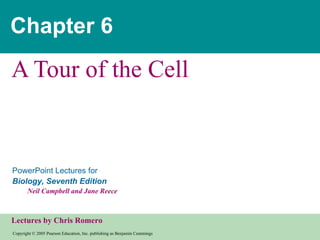Power pt on cell structure
•Descargar como PPT, PDF•
3 recomendaciones•2,598 vistas
Denunciar
Compartir
Denunciar
Compartir

Recomendados
Más contenido relacionado
La actualidad más candente
La actualidad más candente (14)
Similar a Power pt on cell structure
Similar a Power pt on cell structure (20)
Cell (ppt. lecturers for Biology,7th Edition)lecturers by Chris Romero

Cell (ppt. lecturers for Biology,7th Edition)lecturers by Chris Romero
Último
Último (20)
[2024]Digital Global Overview Report 2024 Meltwater.pdf![[2024]Digital Global Overview Report 2024 Meltwater.pdf](data:image/gif;base64,R0lGODlhAQABAIAAAAAAAP///yH5BAEAAAAALAAAAAABAAEAAAIBRAA7)
![[2024]Digital Global Overview Report 2024 Meltwater.pdf](data:image/gif;base64,R0lGODlhAQABAIAAAAAAAP///yH5BAEAAAAALAAAAAABAAEAAAIBRAA7)
[2024]Digital Global Overview Report 2024 Meltwater.pdf
Automating Google Workspace (GWS) & more with Apps Script

Automating Google Workspace (GWS) & more with Apps Script
08448380779 Call Girls In Civil Lines Women Seeking Men

08448380779 Call Girls In Civil Lines Women Seeking Men
Boost PC performance: How more available memory can improve productivity

Boost PC performance: How more available memory can improve productivity
Workshop - Best of Both Worlds_ Combine KG and Vector search for enhanced R...

Workshop - Best of Both Worlds_ Combine KG and Vector search for enhanced R...
Strategies for Landing an Oracle DBA Job as a Fresher

Strategies for Landing an Oracle DBA Job as a Fresher
How to Troubleshoot Apps for the Modern Connected Worker

How to Troubleshoot Apps for the Modern Connected Worker
The 7 Things I Know About Cyber Security After 25 Years | April 2024

The 7 Things I Know About Cyber Security After 25 Years | April 2024
How to Troubleshoot Apps for the Modern Connected Worker

How to Troubleshoot Apps for the Modern Connected Worker
Power pt on cell structure
- 1. Chapter 6 A Tour of the Cell
- 9. Differential-interference-contrast (Nomarski). Like phase-contrast microscopy, it uses optical modifications to exaggerate differences in density, making the image appear almost 3D. Fluorescence. Shows the locations of specific molecules in the cell by tagging the molecules with fluorescent dyes or antibodies. These fluorescent substances absorb ultraviolet radiation and emit visible light, as shown here in a cell from an artery. Confocal. Uses lasers and special optics for “ optical sectioning” of fluorescently-stained specimens. Only a single plane of focus is illuminated; out-of-focus fluorescence above and below the plane is subtracted by a computer. A sharp image results, as seen in stained nervous tissue (top), where nerve cells are green, support cells are red, and regions of overlap are yellow. A standard fluorescence micrograph (bottom) of this relatively thick tissue is blurry. 50 µm 50 µm (d) (e) (f)
- 16. Figure 6.5 Tissue cells Homogenization Homogenate 1000 g (1000 times the force of gravity) 10 min Differential centrifugation Supernatant poured into next tube 20,000 g 20 min Pellet rich in nuclei and cellular debris Pellet rich in mitochondria (and chloro- plasts if cells are from a plant) Pellet rich in “ microsomes” (pieces of plasma mem- branes and cells’ internal membranes) Pellet rich in ribosomes 150,000 g 3 hr 80,000 g 60 min
- 17. In the original experiments, the researchers used microscopy to identify the organelles in each pellet, establishing a baseline for further experiments. In the next series of experiments, researchers used biochemical methods to determine the metabolic functions associated with each type of organelle. Researchers currently use cell fractionation to isolate particular organelles in order to study further details of their function. Figure 6.5 RESULTS
- 22. Figure 6.6 A, B (b) A thin section through the bacterium Bacillus coagulans (TEM) Pili: attachment structures on the surface of some prokaryotes Nucleoid: region where the cell’s DNA is located (not enclosed by a membrane) Ribosomes: organelles that synthesize proteins Plasma membrane: membrane enclosing the cytoplasm Cell wall: rigid structure outside the plasma membrane Capsule: jelly-like outer coating of many prokaryotes Flagella: locomotion organelles of some bacteria (a) A typical rod-shaped bacterium 0.5 µm Bacterial chromosome
- 64. Components of the Cytoskeleton
- 74. Figure 6.25 B Outer doublets cross-linking proteins Anchorage in cell ATP In a cilium or flagellum, two adjacent doublets cannot slide far because they are physically restrained by proteins, so they bend. (Only two of the nine outer doublets in Figure 6.24b are shown here.) (b)
- 75. Figure 6.25 C Localized, synchronized activation of many dynein arms probably causes a bend to begin at the base of the Cilium or flagellum and move outward toward the tip. Many successive bends, such as the ones shown here to the left and right, result in a wavelike motion. In this diagram, the two central microtubules and the cross-linking proteins are not shown. (c) 1 3 2